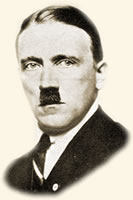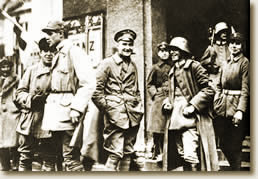|
Adolf Hitler Attempts a Coup, 1923
The "Beer Hall Putsch"
On November 8, 1923 Adolph Hitler led his Nazi followers
in an abortive attempt to seize power in Munich in what became known as the "Beer
Hall Putsch". Although the plan failed, and Hitler imprisoned, the notoriety
the Nazi leader gained laid the groundwork for his rise to the dictatorship of Germany. While in prison, Hitler wrote Mein Kamp, the book that described
his political philosophy and planned conquest of Europe.
At the time of Hitler's attempted coup, Germany's Weimar Republic - which had been established at the end of World War I - was in chaos. Gangs of opposing political groups fought each other in the streets - Communists, Socialists, Nazis, and others resorted to violence in order to promote their political agenda and silence their opponents. Assassinations of unpopular political leaders were a common occurrence. Germany's economy was a shambles. Uncontrollable inflation reduced the value of the money in a worker's
 |
Adolph Hitler
at the time of the putsch |
wallet to next to nothing. Before the start of World War I, just over four German Reichmarks were equivalent to one U.S. dollar. At the beginning of 1923, the exchange rate had risen to 18,000 marks per dollar by July it had reached 350,000 marks and by September, a staggering one hundred million marks per dollar.
In the midst of this turmoil, Hitler saw an opportunity to grab political power
in Munich, rally popular support behind him and topple the German national
government through a march on Berlin. The Nazi leader was inspired by the success
the previous year of Mussolini's March on Rome which installed a Fascist government
in Italy.
On the evening of November 8, 1923 leaders of the Bavarian government were holding
a rally at a Munich beer hall before 3000 spectators. Suddenly, Hitler burst
into the hall, fired a pistol in the air and announced that the building
was surrounded by 600 of his stormtroppers. The Nazi leader whisked the stunned
Bavarian officials off the stage and into a back room where he vowed to hold
them hostage until they expressed support for his revolution. The hostages
soon acquiesced. Unfortunately, the spontaneous enthusiasm Hitler expected
from the local population was not immediately forthcoming. By dawn the following
day, the coup attempt was running out of steam, riddled with confusion and
lack of direction.
However, Hitler had promised a march on Berlin and despite the dwindling chance
of success, he led a column of approximately 2,000 armed followers through
the streets of Munich. Entering a city square, the marching rebels were confronted
by a police unit. Shots rang out and fourteen Nazis were killed in the ensuing
bedlam. Hitler escaped only to be arrested two days later. Tried and convicted
of treason, the Nazi leader was sentenced to five years of confinement under
reasonably comfortable conditions, but actually served only eight months.
The experience taught Hitler that power was to be achieved not through armed conflict but through manipulation of the existing political system.
Egon Larsend was a young man living in Munich. We join his account as Adolph Hitler sits nervously nursing a beer at a bar just outside the entrance to the hall where the rally is taking place. He is awaiting word that his stormtroopers have been deployed around the building:
"A look-out man rushed to Hitler, reporting that the storm trooper lorries were just arriving. With a ham-actor's gesture, Hitler swept his beer glass aside, took out his Browning, and signalled the group of men around him to follow him into the hall.
These men were a motley crowd. Among them were Hitler's bodyguard, a primitive and brutal butcher's apprentice; his former sergeant in the army; Rudolf Hess, who was to become his second-in-command in the party; 'Putzi' Hanfstaengl, the son of Munich's most famous art publisher, who had studied at Harvard together with F.D. Roosevelt, and who would have felt more comfortable at home playing the piano than handling the pistol that had been pushed into his hand.
The planned dramatic effect of the group's march into the hall was somewhat marred by the difficulty of pushing through the perplexed crowd to the platform. Kahr [one of the Bavarian leaders] had stopped speaking, and saw with dismay that a heavy machine-gun was being wheeled into the entrance by uniformed stormtroopers. Some people panicked and tried to leave, but every exit was now guarded, no one was allowed out, and a few who tried were kicked and beaten back.
At last Hitler arrived below the platform, grabbed a chair, mounted it, and fired a pistol shot at the ceiling. There was a sudden silence in the hall. He jumped from the chair and leapt up the steps to the platform. A police major, hand in pocket, tried to bar the way. Hitler put his pistol at the officer's head and shouted, 'Take your hand out of your pocket!' The man obeyed.
Hitler was now in front of the triumvirate Kahr, Lossow, and Seisser [the three Bavarian leaders]. He turned to the audience and declared in a hoarse, excited voice: 'The national revolution has started. The building is guarded by six hundred heavily armed men. The barracks of the Reichswehr [army forces] and police have been occupied. Reichswehr and police are now on the march under the swastika banner!'"
Hitler was bluffing. The Nazis did not have control of the local army nor the police. Hitler forced the three political leaders into a small room behind the stage where he attempted to extort their allegiance to his plot:
"The three listened in silence, anxiously watching the excited man with his pistol and the armed guards barring the way out. Hitler ended with the threat: 'Anyone who refuses to collaborate with me has no right to live. I have four bullets in my gun three for my collaborators if they abandon me and the last for myself.' He put the barrel to his temple: 'If I am not victorious by tomorrow, I shall be a dead man.'
Kahr was the first to answer. 'You can have me shot or shoot me yourself,' he said calmly, 'or just lock me up. A life more or less makes no difference.' Seisser: 'But Herr Hitler, you promised me a few days ago that you wouldn't stage a putsch!' Hitler: 'Yes, I promised. But I had to do it, for the good of the fatherland.' He called his bodyguard to get him another glass of beer.
Suddenly he seemed to get rattled as his prisoners did not declare their enthusiastic allegiance. He jumped up and ran out on to the platform. Here, during the quarter of an hour of his absence, the scene had changed. Hermann Goering, at that time commander of the SA, had arrived, and occupied the deserted speaker's rostrum. He was in full gala uniform, with medals pinned to his chest - awarded to him during the war as a pilot, squadron leader, and eventually commander of Richthofen's famous 'air circus'. He had joined Hitler's party only a year earlier.
 |
Some of Hitler's storm troopers
mingle
outside the beer hall. November 9, 1923 |
Goering appeared just in time to tame the three thousand people in the hall who were getting restless, despite the threatening machine-guns and pistols around them. What, they wanted to know, was happening in that back room? 'Don't worry,' Goering told them. 'No harm will come to Herr von Kahr, to Lossow and Seisser. They are holding preliminary discussions for the formation of a national government which all of you want.'
'You don't need machine-guns and hundreds of armed men for that,' cried someone, and there was a roar of applause.
'Shut up!' Goering snarled arrogantly. 'You've got your beer, haven't you?'
Now Hitler came dashing back. The excitement in the hall, far from abating, heightened. He seemed to have lost. Again he drew his pistol and fired a shot at the ceiling. 'If you don't keep quiet,' he shouted, 'I'll have another machine-gun put in the gallery!' At last there was silence, and he started anew, calmly and without his usual melodramatic gimmicks. What was happening, he said, was in no way directed against Kahr, who would remain in control of Bavaria. But a new Reichs government had to be formed, with Ludendorff, Lossow, Seisser and himself. 'There are these three men in the back room, wrestling with their conscience,' he said, putting on a touch of emotion. 'Can' I tell them that all of you will be behind them?'
'Ja, ja,' came the thunderous answer. He had succeeded in swinging the mood of the crowd on his side in a matter of minutes - it was a demagogue's masterstroke. 'In a free Germany,' he went on, now with passion, 'there will be a place for an independent Bavaria!' And he ended on his favourite heroic note; here was the man of destiny pleading for the hearts and souls of the people: 'This I can tell you, either the German revolution begins tonight, or we shall all be dead by tomorrow morning.'"
At this point General Ludendorff, commander
of the German forces on the Western Front at the end of World War I and a German
national hero, arrived at the beer hall. Ludendorff had lent his support to
Hitler's coup attempt and had been brought to the hall to persuade the three
Bavarian leaders to give in to Hitler's demands. The effort was successful as
the Bavarian politicians voiced their support and were released. Once free, however,
they recanted and the local army garrisons were ordered to halt the coup attempt.
References:
Egon Larsen's account appears in: Larsen, Egon, Weimar Eyewitness (1976); Bullock, Alan, Hitler, a Study in Tyranny (1960); Gordon, Harold, Hitler and the Beer Hall Putsch (1972).
How To Cite This Article:
"Adolf Hitler Attempts a Coup, 1923," EyeWitness to History, www.eyewitnesstohistory.com (2005).
|






